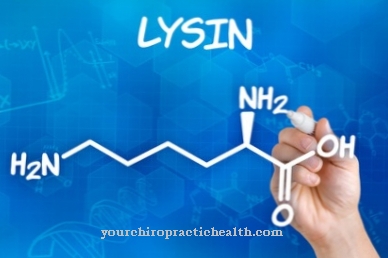Of the Bayliss effect keeps the blood supply to organs such as the brain and kidneys constant despite daily fluctuations in blood pressure. At increased pressure values, the effect induces vasoconstriction of the vascular muscles. Disturbances of the Bayliss effect lead to persistent hyperemia and edema formation in the extracellular space.
What is the Bayliss Effect?

Blood pressure values are subject to fluctuations from day to day. Despite these fluctuations, the organ blood flow must be kept constant. The Bayliss effect contributes to the constant maintenance of organ blood flow. This myogenic autoregulation was first described by the British physiologist Bayliss and corresponds to a contraction reaction of the blood vessels, which maintains the constancy of the blood flow in organs and tissues as part of the local control in the bloodstream.
The blood vessels are equipped with smooth muscles. When the blood pressure changes, the vascular muscle cells react to the new situation by either contracting or relaxing. The activation of mechano-sensitive receptors within the blood vessels is considered to be the molecular cause of the Bayliss effect. The Bayliss effect ultimately corresponds to a variant of circulatory regulation that is independent of the vegetative nervous system and its nerve fibers. While the effect has been demonstrated for the kidneys, gastrointestinal tract and the brain, the phenomenon does not seem to play a role in the skin and lungs.
Function & task
When blood flow increases in the small arteries or arterioles due to increased blood pressure values, this triggers vasoconstriction.This is the contraction of the smooth vascular muscles, which in this case corresponds to a reaction to a pressure stimulus and can therefore be referred to in the broadest sense as a reflex. The mechanoreceptors in the vessels register the change in pressure and trigger the vasoconstriction. This increases the flow resistance in the affected vessels. The blood flow in the supply area of the vessels remains constant despite fluctuations in blood pressure.
As soon as the mechanoreceptors in the vessels register lower blood pressure values again and thus register a decrease in blood flow, vasodilation is initiated. The muscles of the vessels relax again to their basal tone. In this way, the Bayliss effect keeps the blood flow to the kidneys, gastrointestinal tract and brain largely constant and regulates the values in these areas of the body relatively autonomously.
The Bayliss effect shows efficiency at systolic blood pressure values of 100 to 200 mmHg. The effect is based on molecular mechanisms. Arteries and arterioles with the Bayliss effect have mechano-sensitive cation channels in their walls. When these cation channels are opened, calcium ions flow into the muscle cells and form a complex with the protein calmodulin.
When it binds to a complex, the enzyme myosin light chain kinase is activated. When phosphorylation takes place in the sense of an interconversion of this kinase, the motor protein myosin II is activated. This motor protein enables vascular smooth muscle cells to contract.
For every muscle contraction, the myosin and Atkin filaments in the muscle have to slide into each other. Myosin II is involved in this movement as it is responsible for the binding site to the Atkin filament of the muscles.
The Bayliss effect is a type of circulatory regulation that works independently of the vegetative innervation of the blood vessels. Even if the vegetative connection is cut by severing the supplying nerves, the Bayliss effect is retained. The mechanism can only be blocked by the use of antispasmodics such as papaverine, which relax the vascular muscle cells.
Illnesses & ailments
A disruption or even cancellation of the Bayliss effect can have serious consequences for the organism. Permanent hyperemia of the organs in the affected supply area can be the result, for example. Hyperemias are increased blood flow to a specific tissue or organ, as can be caused by the expansion of the supplying blood vessels as part of vasodilation. Hyperemia is usually the accompanying symptom of inflammation and is usually caused by locally released mediators. In addition, hyperemia is often associated with ischemia, which can cause loss of muscle tone and an associated decrease in wall tension in the vessels.
The cancellation of the Bayliss effect can result in the transfer of fluid into individual organ structures due to the resulting hyperemia of a certain supply area. This can lead to extracellular edema. Edema is preceded by the escape of fluid from the vessels, which eventually accumulates in the interstitial space. The formation of edema is always preceded by a change in fluid movements between the interstitium and the capillaries. The principles of the Starling equation play a major role for the liquid discharge.
In addition to the hydrostatic pressure of the blood capillaries, the difference in oncotic vascular pressure between the capillaries and the interstitial space plays a role. The hydrostatic and oncotic pressure act against each other. While the hydrostatic pressure causes the leakage of water into the interstitial space, the oncotic pressure binds fluid within the capillaries. The two forces are usually almost in equilibrium.
Edema can only develop in the context of deviating pressure values that are no longer balanced. Such abnormal pressure values occur, for example, when the Bayliss effect fails. Since the ion channel TRPC6 in particular is involved in the Bayliss effect, mutations in the gene coding for it can cause disturbances in the effect. In the meantime, for example, rare hereditary diseases of the kidneys have been traced back to a mutation in the TRPM6 gene. Mutations can change the protein in the ion channel so much that it no longer works. A magnesium deficiency and a disturbed calcium supply within the cells is the result.













.jpg)

.jpg)
.jpg)











.jpg)